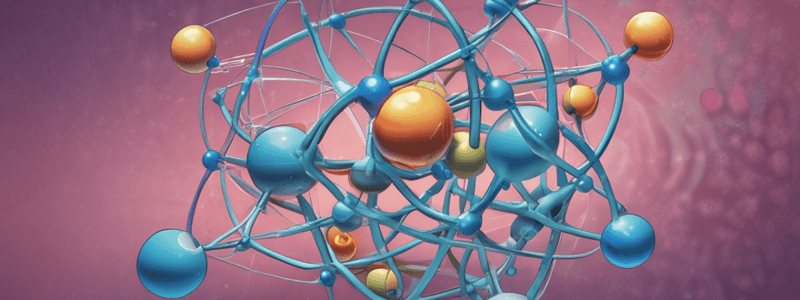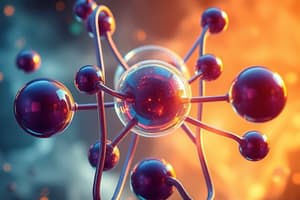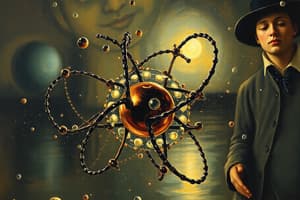Podcast
Questions and Answers
Which type of bond is the strongest among chemical bonds?
Which type of bond is the strongest among chemical bonds?
- Hydrogen bond
- Covalent bond
- Ionic bond (correct)
- van der Waals forces
What kind of interaction is critical for processes such as sending signals and copying information within a cell?
What kind of interaction is critical for processes such as sending signals and copying information within a cell?
- Weak interactions (correct)
- Covalent bonds
- Ionic bonds
- Metabolic reactions
What are van der Waals forces responsible for?
What are van der Waals forces responsible for?
- Attraction between hydrogen and oxygen atoms
- Formation of ionic bonds
- Attraction between molecules that are close together (correct)
- Creation of covalent bonds
What condition strengthens the van der Waals forces between molecules?
What condition strengthens the van der Waals forces between molecules?
What demonstrates the strength of combined van der Waals forces in nature?
What demonstrates the strength of combined van der Waals forces in nature?
Between which atoms do hydrogen bonds typically form?
Between which atoms do hydrogen bonds typically form?
Why are hydrogen bonds essential in understanding water's properties?
Why are hydrogen bonds essential in understanding water's properties?
Which statement about the importance of weak interactions in living cells is true?
Which statement about the importance of weak interactions in living cells is true?
If a calcium atom loses two electrons to become a calcium ion, what charge does it acquire?
If a calcium atom loses two electrons to become a calcium ion, what charge does it acquire?
Given that a chlorine atom gains one electron to become a chloride ion, what is the charge on the chloride ion?
Given that a chlorine atom gains one electron to become a chloride ion, what is the charge on the chloride ion?
Flashcards are hidden until you start studying
Study Notes
The Nature of Matter
- All living things are made up of chemical compounds, which are the building blocks of life.
- The human body uses substances from food and water to carry out chemical reactions that keep it alive.
Atoms
- The atom is the basic unit of matter, and it consists of subatomic particles: protons, neutrons, and electrons.
- Atoms are incredibly small, with 100 million sulfur atoms lined up side by side being only about 1 centimeter long.
- The concept of the atom originated from the Greek philosopher Democritus, who called the smallest fragment of any substance an atom, meaning "unable to be cut".
Protons and Neutrons
- Protons and neutrons have roughly the same mass, but protons are positively charged, while neutrons carry no charge.
- Strong forces bind protons and neutrons together to form the nucleus at the center of the atom.
Electrons
- Electrons are negatively charged particles with a much smaller mass than protons.
- Electrons are in constant motion in the space surrounding the nucleus, and they are arranged in a series of shells or orbitals.
- The number of electrons in an atom is equal to the number of protons, making the atom electrically neutral.
Elements and Isotopes
- A pure substance that consists entirely of one type of atom is called an element.
- Elements are represented by one or two-letter symbols, such as C for carbon, H for hydrogen, and Na for sodium.
- The number of protons in the nucleus of an element is its atomic number, which determines its identity.
- Isotopes are atoms of the same element that have different numbers of neutrons, resulting in different mass numbers.
- The atomic mass of an element is the weighted average of the masses of its isotopes.
Isotopes of Carbon
- Carbon has several isotopes, including Carbon-12, Carbon-13, and Carbon-14, which differ in their number of neutrons.
- The atomic mass of carbon is the weighted average of the masses of its isotopes.
Radioactive Isotopes
- Some isotopes are radioactive, meaning their nuclei are unstable and break down at a constant rate over time.
- Radioactive isotopes can be used to detect cancer, kill bacteria, and label substances in the body.
Chemical Compounds
- A chemical compound is a substance formed by the chemical combination of two or more elements in definite proportions.
- Chemical compounds have physical and chemical properties that are usually different from those of the elements they are composed of.
- Chemical formulas, such as H2O for water and NaCl for table salt, show the composition of compounds.
Chemical Bonds
- Chemical bonds are formed when atoms are rearranged to hold together.
- The main types of chemical bonds are ionic bonds and covalent bonds.
- Ionic bonds are formed when one or more electrons are transferred from one atom to another, resulting in the formation of ions with opposite charges.
- Covalent bonds are formed when electrons are shared between atoms, resulting in a molecule.
Ionic Bonds
- Ionic bonds are formed when atoms gain or lose electrons to achieve a stable number of electrons.
- Positively and negatively charged ions are attracted to each other, forming an ionic bond.
Covalent Bonds
- Covalent bonds are formed when electrons are shared between atoms.
- The moving electrons travel about the nuclei of both atoms, forming a covalent bond.
- When atoms share one electron, a single covalent bond is formed, and when they share four electrons, a double bond is formed.
Weak Interactions
- Weak interactions, such as van der Waals forces and hydrogen bonds, play important roles in the chemistry of living things.
- Van der Waals forces are the attraction between molecules, and they can be strong enough to hold molecules together.
- Hydrogen bonds are essential to understanding the special properties of water.
Studying That Suits You
Use AI to generate personalized quizzes and flashcards to suit your learning preferences.




